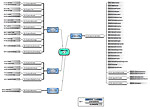Within the underlying metadata dictionary, the PBCore implies no hierarchical
relationships (root, branches, leaves). However, in applying the elements from the metadata dictionary within an asset management system, or more importantly, when sharing metadata descriptions from a data export as a properly formatted XML document (that follows the PBCore XML Schema Definition: XSD)
hierarchical
relationships and interdependices between PBCore elements emerge as roots, branches and leaves.
These roots, branches, and leaves are alternatively expressed in a data model as "Content Classes,'
"Containers," "Sub-Containers," "Elements." PBCore has...
- 53 elements
- arranged in 15 containers
- and 3 sub-containers
- all organized within 4 content classes.
CONTENT CLASSES
In the hierarchy of objects in the PBCore Description Document/Master Container, Content Classes are created as "conceptual wrappers" that cluster together a list or structure of thematically-related Elements (metadata fields and their attributes and properties). PBCore maintains four Content Classes as the conceptual wrappers for its various metadata elements:
- PBCoreIntellectualContent
9 containers; 16 elements
(metadata elements describing the actual intellectual content of a media asset or resource)
- PBCoreIntellectualProperty
4 containers; 7 elements
(metadata elements related to the creation, creators, usage, permissions, constraints, and use obligations associated with a media asset or resource)
- PBCoreInstantiation
1 container, 3 sub-containers; 28 elements
(metadata elements that identify the nature of the media asset as it exists in some form or format in the physical world or digitally)
- PBCoreExtensions
1 container; 2 elements
(additional descriptions that have been crafted by organizations outside of the PBCore Project. These extensions fulfill the metadata requirements for these outside groups as they identify and describe their own types of media with specialized, custom terminologies unique to their needs and community requirements)
ELEMENT CONTAINERS & SUB-CONTAINERS (aka "branches"):
Elements are objects in the PBCore schema hierarchy that define a metadata field and its values, attributes and properties. An element may be standalone. If several metadata fields are thematically related to each other, they can be bound together under an Element Container. Related elements are governed by a larger theme, and should be bound together when data is shared (particularly if an Element Container is a repeatable description with multiple instances of its related Elements). Examples of related Elements bound within a Container are *title* and its associated *titleType*, that are bound together by the Element Container *PBCoreTitle*. Within hierarchical structures, a Container may house Sub-Containers, which themselves bind together related Elements. In PBCore, there are Sub-Containers found within the Content Class PBCoreInstantiation.
ELEMENTS (aka "leaves"):
Elements are objects that define a metadata field and its values, semantics, attributes, and properties (for a list of the attributes defined for PBCore elements, see our web page PBCore Element Attributes). An Element is the actual "thing" that carries the descriptive metadata about a media item, such as a title, a date, keywords, rights information, mime types, media types, etc. The metadata elements are what a cataloger interacts with (creating descriptions) within a cataloging tool or asset management system.
An advantage to using the Element Container approach is that, unlike the basically flat arrangement of elements found in Dublin Core (http://www.dublincore.org), PBCore is able to bind together the data found in related elements and keep them that way. For example, a *title* and its associated *titleType* can be catalogued and bound together as one instance of the container *pbcoreTitle*. The container *pbcoreTitle* can be repeated within a single metadata record, with another *title* and *titleType*. For example, a working title or an alternative title can be specified, but still be part of one data record, instead of making multiple data records, each with redundant metadata (descriptions, keywords, coverage, etc.). Similarly a particular format (and its associated specifications) for a media item can be described within the container *pbcoreInstantiation*, and repeated multiple times for different formats/instantiations, all within a single metadata record.
Click on the thumbnail image below to open a high resolution diagram of PBCore v1.1, showing its structure.
PBCore v1.1
- 4 Content Classes
- 15 Element Containers
- 3 Sub-Containers
- 53 Elements
|
 |
To see a table of the elements organized by Content Classes, link to our web page PBCore Elements Viewed by Content Classes.
For an expanded discussion, link to our web page on Hierarchical Relationships and Element Interdependencies.



